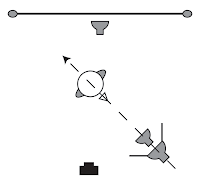| photo ©2009-2010 terese prodell |
As I try and teach myself the "proper" way to light a studio portrait, I thought I'd take the time to share what I'm learning with you if for no other reason than to solidfy the information in my mind.
There are five basic portrait lighting set-ups and the first one is paramount lighting. Paramount lighting is also called butterfly lighting because of the shadow that forms under the subject's nose. (See image above)
 Looking at the lighting diagram, you can see that the basic set up has both the key light and the fill light on the same line at a 45º angle from the camera line. The lights are set one above the other. The downward angle of the key light produces the harsh shadow under the nose and the diffused fill flash reduce the harsher shadows under the chin.
Looking at the lighting diagram, you can see that the basic set up has both the key light and the fill light on the same line at a 45º angle from the camera line. The lights are set one above the other. The downward angle of the key light produces the harsh shadow under the nose and the diffused fill flash reduce the harsher shadows under the chin.You'll also notice that in the diagram there is a flash unit aimed at the backdrop. Your subject should in front of the backdrop far enough so that none of the light from the key and fill lights (or as little of it as possible) reflect off the backrdrop. If you want your backdrop to be visible you'll need to light it separately.
One final note. Almost all portrait lighting set-up diagrams will include a hair light which is placed above and a little behind the subjects head so that the light it projects falls on the back and side of the head "rimming" or creating a halo effect as it reflects off the subjects hair. This is to separate the subject from the background adding depth to the portrait. I don't have it here because it's not strictly necessary although it can be very helpful with certain subject and backdrop combinations.
By the way, you don't need a lot of expensive equipment to do these set-ups. You can find cheap off-camera flashes at any camera store. I purchased my flashes at Midwest Photo Exchange for $85. Click on the "Strobist" link on the navbar on the left-hand side of the site to find basic lighting kits and accessories and check out the Strobist blog for more off-camera flash info.


No comments:
Post a Comment